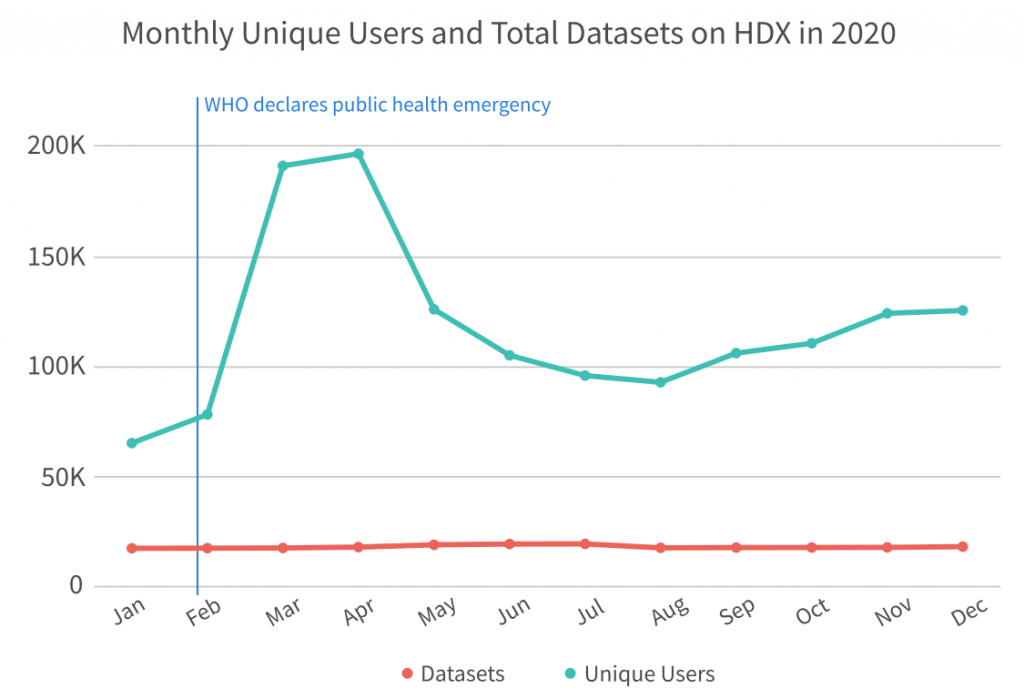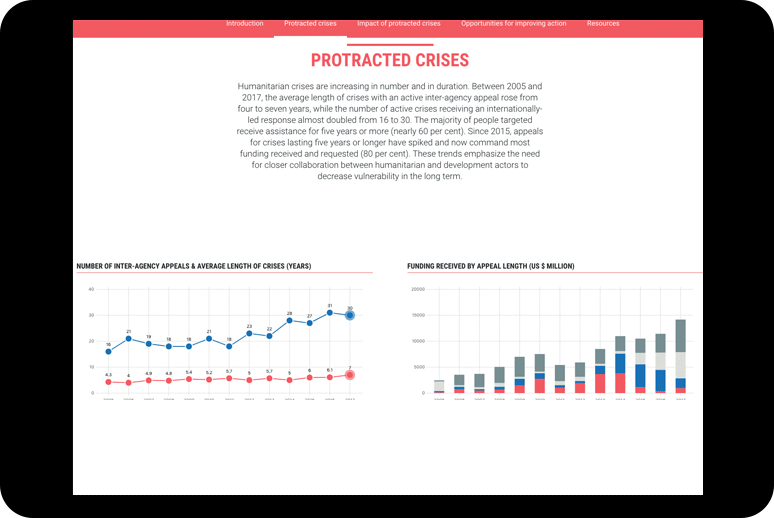Share
The Humanitarian Data Exchange (HDX) saw record growth in 2020 with over 1.3 million people using the platform (compared to 600,000 people in 2019) and over 2.2 million datasets downloaded (compared to 930,000 in 2019). Below I provide a closer look at the most popular datasets and the new organizations that we welcomed to the platform throughout the year.
In March 2020, we created a dedicated COVID-19 pandemic page to make it easier for users to find COVID-19 data across all affected countries. The page brings together almost 100 datasets related to COVID-19 cases and deaths, government measurements in response to the pandemic, travel restrictions, school closures, impacts on immunization campaigns and more. The demand for data related to the COVID-19 pandemic caused a spike in users unlike any other crisis covered by HDX: almost 200,000 people visited the site in both March and April, following WHO’s declaration of a public health emergency in late January.

The top five most downloaded datasets during 2020 were the following:
- Novel Coronavirus (COVID-19) Cases contributed by Johns Hopkins University Center for Systems Science and Engineering. This dataset contains the number of COVID-19 cases and deaths from around the world and it is compiled from various sources including WHO, national ministries of health, the US Center for Disease Control, the European Centre for Disease Prevention and Control, and news outlets, among other sources. This dataset was downloaded 334,000 times.
- COVID-19 Government Measures contributed by ACAPS. This dataset brings together the measures implemented by governments worldwide in response to the pandemic. The non-pharmaceutical interventions are categorized into five groups: social distancing, movement restrictions, public health measures, social and economic measures, and lockdowns. This dataset was downloaded 22,000 times.
- COVID-19 Tests Performed by Country from Our World in Data. This dataset is disaggregated by country, total daily tests, total positive test rates, total tests per 1,000 people, and tests per confirmed case. This dataset was downloaded 14,000 times.
- Movement Range Maps contributed by Facebook. These datasets are intended to inform researchers and public health experts about how populations are responding to physical distancing measures. In particular, there are two metrics, Change in Movement and Stay Put, that provide a slightly different perspective on movement trends. This dataset was downloaded 13,000 times.
- Coronavirus (COVID-19) Cases and Deaths contributed by WHO. The dataset contains COVID-19 cases and deaths at the country level reported through official channels as mandated by the International Health Regulation. This dataset has 7,200 downloads.
Most of this data was incorporated into the HDX COVID-19 Data Explorer which brings together over 60 datasets from 25 sources to help decision makers prioritize aid distribution across 50+ locations with humanitarian crises.
We welcomed 38 new organizations to HDX in 2020. A few highlights include:
- Integrated Food Security Phase Classification (IPC) shared data related to their acute food insecurity scale. Of the 28 datasets shared, 26 are country-specific, one is regional and one is global. The global dataset includes data for all countries and is among the most downloaded, along with country-level data for Afghanistan, Ethiopia and Yemen.
- The World Bank shared datasets related to indicators for gender, poverty, labor, health, environment, education, economy, aid, finance, trade, and climate change covering most countries in the world. The World Bank also shared a dataset with the results of their high-frequency monitoring system that tracks the impact of the COVID-19 pandemic in 44 countries.
- Global Health 50/50 shared a global dataset with the latest available sex-disaggregated data on confirmed COVID-19 cases and deaths in affected countries.
- Geo-Referenced Infrastructure and Demographic Data for Development (GRID3) uses high-resolution geospatial data to produce estimates on population settlements, infrastructure, and boundaries. GRID3 shared 60 country-specific datasets on population settlements.
- Centre for Research on the Epidemiology of Disasters (CRED) shared a dataset with aggregated figures from their Emergency Events Database (EM-DAT).
The data they contributed helps to fill gaps in coverage across crises, and ensures HDX continues to be a key resource for the humanitarian community and beyond. Our just-published report on The State of Open Humanitarian Data provides an overview of the data that is available or missing across 27 locations. At the start of 2021, we estimate that just 51 percent of relevant, complete crisis data is available. The current status of data completeness is always available on the Overview of Data Grids page on HDX.
We look forward to working with new and existing organizations in the coming year. Join us for periodic events and deep-dives on the data that is available on HDX. Visit the Centre’s YouTube channel to catch up on previous webinars featuring data from CRED, IPC, the World Bank and Worldpop.
